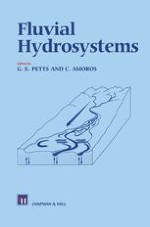1996 | OriginalPaper | Chapter
Aquatic invertebrates
Authors : M. T. Greenwood, M. Richardot-Coulet
Published in: The Fluvial Hydrosystems
Publisher: Springer Netherlands
Included in: Professional Book Archive
Activate our intelligent search to find suitable subject content or patents.
Select sections of text to find matching patents with Artificial Intelligence. powered by
Select sections of text to find additional relevant content using AI-assisted search. powered by
From the source of the river, the longitudinal gradient of ecological conditions corresponds to a spatial sequence of faunal communities. This distribution of species is the result of (a) adaptive strategies to physical parameters such as, water temperature, flow velocity and shear stress, and bed-sediment size, and (b) strategies which optimize the utilization of food resources and available living space. Along a river, the flow of water determines both the connectivity between, and the general characteristics of, the different sectors. Similarly, in the floodplain the aquatic environments (cut-off channels and permanent backswamps) are fed from the main river either directly during floods or indirectly, by exchanges with the alluvial aquifer. However, hydrological connectivity between aquatic environments within the floodplain is discontinuous both in space and time, and the importance of this linkage depends not only on its strength and duration (Figure 7.1) but also on its timing. A variety of aquatic environments are created by the differing degrees of connectivity and give rise to a mosaic of interlinking habitat patches and communities. Three concepts have been proposed to explain the functioning of the river and its floodplain: the River Continuum Concept (Vannote et al., 1980), the Nutrient Spiralling Concept (Webster, 1975; Newbold et al., 1981) and the Flood Pulse Concept (Junk et al., 1989).
